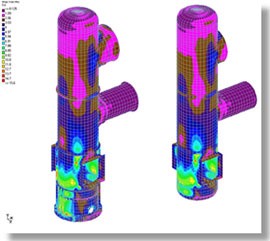Mechanical Integrity utilizing FEA is first an assessment of existing condition, thicknesses, welds and attachments. Loads cases are determined based on codes and include wind, thermal, dead and live loads, etc. The object is then modeled in a FEA application to generate color coded stress levels.

FEA Stacks
Stacks with attachments such as platforms need special attention to wind loads and localized stress levels. Strakes may be required for resonance due to vortex shedding.
3D modeling is used to develop the stack geometry. The model is imported into our STAAD FEA application and the various load cases are executed. Red shades indicate higher stress levels.
Blue shades indicate lower stress levels. Flange connections can be subjected to moment forces that could distort proper fit-up.
FEA Pressure Vessels
Pressure vessels are analyzed utilizing COMPRESS software. Nozzle loads are susceptible to connected piping and relative movement between the vessel and piping. Thermal induced stresses could be significant.
Relief valve operation will induce loads on the connected nozzle.
Relief valve discharge piping needs to be reviewed for possible binding at restraints.


FEA Material Transfer Chutes
A material handling transfer chute (shown to the left) is analyzed for stresses at several wall thicknesses.
As can be seen, upper sections of the chute have higher stress levels and may require thicker plate material.

